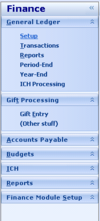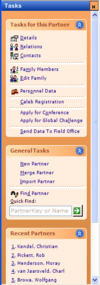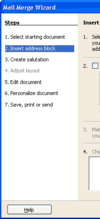Creation of a UserControl: Task List
Introduction
There are three different styles in which a list of 'Task Items' should be able to be displayed in openPETRA:
With 'Task Items' we mean the list of text items within a surrounding panel.
The Task Items will perform varying functionality when clicked or selected by keyboard - depending on the context in which the Task Items are to be shown. The performing of the functionality is outside of the scope of this implementation as this will be done by the Control who 'hosts' the Task Items (a Panel of some sort).
Desired Outcome
- Creation of one UserControl which can present a list of 'Task Items' in the three different styles shown in the introduction.
- The different styles will need to affect
- the font
- the background colour
- also needs support for gradient backgrounds (see 'Menu Items in Accordion Panel' in the introduction)
- indentation of Task Items
- space between Task Items
- compare 'Menu Items in Accordion Panel' and 'Pages in Shepherd Navigation Panel' in the introduction
- appearance of dividing lines (see below)
- appearance of disabled Task Items (see below)
- The different styles will need to affect
- The UserControl needs to accept the Task Items as a single XmlNode.
- This XmlNode will have child XmlNodes which represent the actual Task Items.
- The UserControl needs to be able to 'grow' or 'shrink' itself in vertical direction - depending on the number of XmlNodes (also dynamically, as some Task Items might be hidden initially).
- Calling of a Delegate (.NET implementation of a Callback) on 'activation' (clicking or keyboard-selection) of a Task Item.
- Implement optional automatic numbering of Task Items ("1. xxx", "2. yyy") (See 'Pages in Shepherd Navigation Panel' in the introduction).
- Implement Sub-task Items (only one level deep), which are found as children of the XmlNodes of the Task Items. Sub-task Items should be shown indented under their 'parent' Task Items and follow the numbering of their 'parent' Task Item, if optional numbering is switched on ("1.1 xzxz", "1.2 yzyz" under "1. xxx").
- Navigation between the Task Items and 'activating' of a Task needs to be possible by keyboard!
- <CURSOR-UP> and <CURSOR-DOWN> keys for navigation
- <ENTER> or <SPACE> keys for 'activation' of selected item
- 'Highlighting' of currently selected Task Item. The style of the highlighting will be different between the three different display styles.
- see 'Pages in Shepherd Navigation Panel' in the introduction (rectangle with dotted line within the blue selection)
- Task Item text will need to be able to show an underlined character (designated by an ampersand & sign in the text) and the Task Item will need to be 'activated' if the user presses <ALT>+<{underlined character}>.
- see 'Menu Items in Accordion Panel' in the introduction (&Transactions Task Item)
- Optional 'highlighting' of 'activated' Task Item. The style of the highlighting will be different between the three different display styles and be different from the highlighting of the currently selected Task Item.
- compare 'Menu Items in Accordion Panel' and 'Pages in Shepherd Navigation Panel' in the introduction
- Disabled Task Items will need to be shown differently and the user must not be able to 'activate' them or navigate to them.
- Appearance should be 'greyed out', except for Task Items in style 'Menu Items in Accordion Panel' - those should be shown 'etched'.
- Hidden Task Items must be possible.
- Those should not be shown, but it must be possible to show them programmatically at any time.
- Public Methods for Disabling/Enabling and Hiding/Showing of individual Task Items must be implemented.
- OPTIONAL: Ability for drawing of dividing lines between Task Items would be nice (see 'Action Items in Task Panel' in the introduction)
- Appearance of dividing lines should be different on different Display Styles (e.g. dashed or solid line, different colour of the line, etc.)
- OPTIONAL: Optional Icons in front of task items would be nice.
- When at least one icon is present, all the Task Items will need to be indented by the width of the icons plus a few pixels for spacing
- see 'Action Items in Task Panel' ('General Tasks' Panel) in the introduction
- Icons need to be reduced to a 'dimmed greyscale representation' if their corresponding Task Item is disabled
- When at least one icon is present, all the Task Items will need to be indented by the width of the icons plus a few pixels for spacing
Outline of the Solution
This lists the basic steps for getting to the desired outcome.
Where references are made to items which are described in the 'Desired Outcome' section, '[REF]' will be mentioned.
Step 1
- Create a new UserControl within the Ict.Common.Controls C# Project and name its file 'TaskItemList.cs'. Name the Class 'TTaskItemList'.
- Add a 'MasterXmlNode' Property of type XmlNode.
- Create the Task Items according to the XmlNodes present in the 'MasterXmlNode' Property.
- The Task Items need to be rebuilt if the 'MasterXmlNode' Property is changed!
- Implement the building of the Task Items in a private Method that gets called from the 'setter' of this Property.
- Task Items shall be represented as LinkLabels Controls. Their Text Property should be set from the 'Label' Child Node of each TaskItem's XmlNode.
- A simple example implementation can be found in the Constructor of Class Ict.Common.Controls.TPnlAccording (look at the inner 'while' loop that creates LinkLabels).
- The Task Items need to be rebuilt if the 'MasterXmlNode' Property is changed!
- Add ability to the UserControl to 'grow' or 'shrink' itself in vertical direction [REF].
- Test and demonstrate this in a small test application, which you should create for that purpose.
At that point this early version of the UserControl could be given to the implementors of the 'Collapsing Panel' Project so they can implement the hosting of this UserControl.
Step 2
- Add a public Enum 'TDisplayStyles', holding three 'Display Styles': 'AccordionPanelStyle', 'TaskPanelStyle' and 'ShepherdNavigationStyle' [REF].
- Add a 'DisplayStyle' Property of Type 'TDisplayStyles'.
- Implement the change of display style in a private Method that gets called from the 'setter' of this Property.
- Change of display style needs to affect various things (e.g. font, indentation) [REF].
- Add ability to have disabled Task Items and hidden Task Items [REF].
- Should be set from the 'Enabled' and 'Hidden' Child Nodes of each TaskItem's XmlNode, respectively
- Add public Methods 'DisableTaskItem' and 'EnableTaskItem' as well as 'HideTaskItem' and 'ShowTaskItem' to be able to toggle these attributes programmatically at run time
- Those Methods need to have a XmlNode Argument which specifies the desired TaskItem.
- Implement optional automatic numbering of Task Items ("1. xxx", "2. yyy")
- Add Property 'AutomaticNumbering' of Type bool
- Set this Property automatically to true when switching 'DisplayStyle' to the 'Shepherd Navigation' style.
- Automatic numbering needs to work with every style.
- Implement Sub-task Items (only one level deep) [REF].
- continue automatic numbering (nested) if switched on [REF]!
- Test and demonstrate the new functionality in the test application.
Step 3
- Add capability for painting Dividing Lines between Task Items [REF]
- Those shall be represented as XmlNodes whose 'Label' Child Node of the TaskItem's XmlNode is "-".
- Note: This is an optional feature.
- Add capability for optional Icons in front of task items [REF]
- The icon file name would be specified in the 'IconName' Child Node of each TaskItem's XmlNode.
- Note: This is an optional feature.
- Add navigation by keyboard between the Task Items and 'activating' of a Task [REF].
- Dividing lines and disabled Task Items must be skipped over when navigating with the keyboard (hidden Task Items as well, obviously)
- Create a Delegate (.NET implementation of a Callback) named 'TaskItemActivated' [REF]
- Needs to have an Argument of type XmlNode that points to the Task Item that got 'activated' (see next bullet point).
- Call Delegate 'TaskItemActivated' on 'activation' (clicking or keyboard-selection) of a Task Item [REF].
- Test and demonstrate the new functionality in the test application.
Step 4
- Add .NET Attributes to Properties, public Methods and to the Delegate for use in the WinForms Designer.
- Test and demonstrate the UserControl in the WinForms Designer.
- Add XML Documentation to
- the Class
- the Properties
- public and private Methods
- the Enum
- the Delegate
- Check conformance with the openPETRA Code Style Guide!
Approval of Functionality and Program Code
- Have both the functionality and the program code reviewed by ChristianK and Prof. Nurkkala.
- If the implementors of the 'Collapsing Panel' Project have already added the ability to host this UserControl: demonstrate this UserControl in combination with the 'Collapsing Panel'.
- Show the UserControl in the WinForms Designer. Documentation of Properties, Events and the design-time experience will be evaluated by ChristianK and Prof. Nurkkala.


